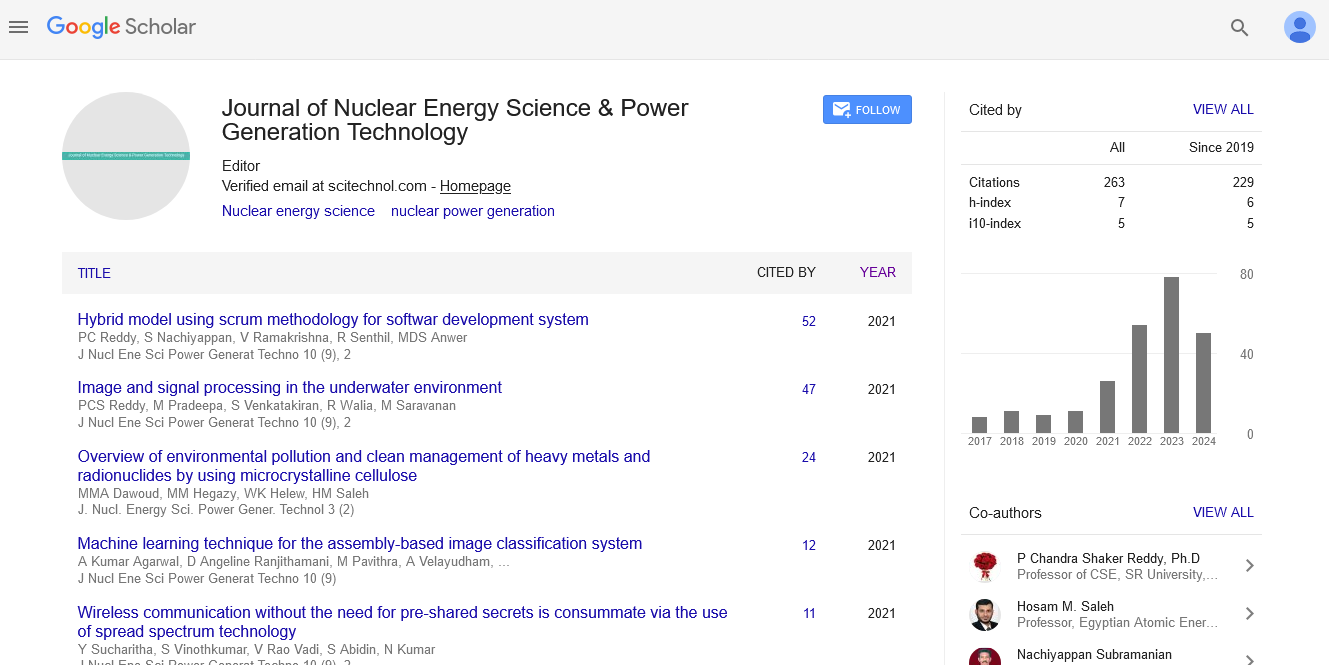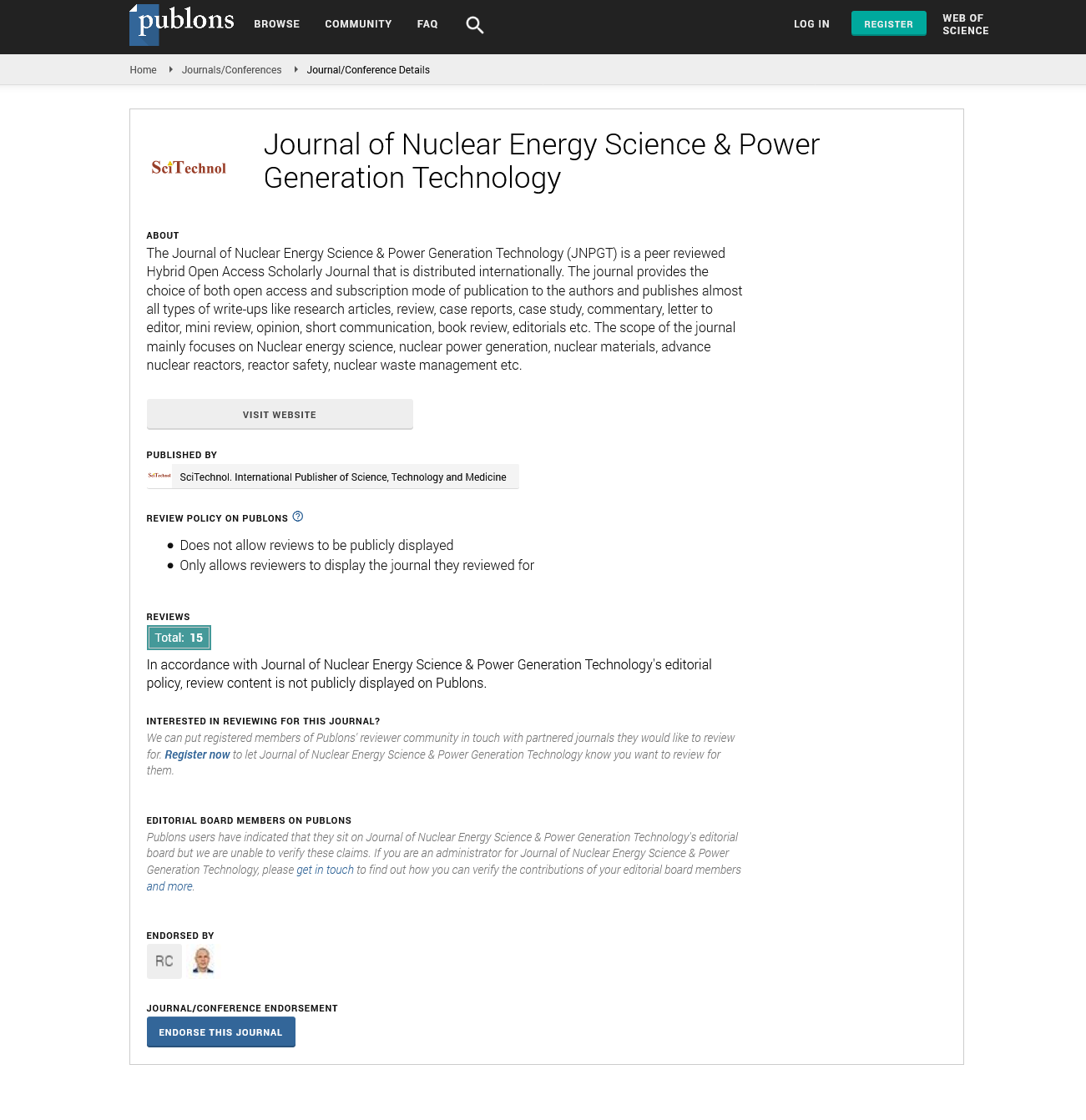Opinion Article, J Nucl Ene Sci Power Generat Technol Vol: 13 Issue: 4
Enhanced Energy Confinement in Magnetic Fusion Devices through Advanced Diverter Concepts
Kirsa Oia*
1Department of Physics and Astronomy, Materials Physics, Uppsala University, Uppsala, Sweden
*Corresponding Author: Kirsa Oia,
Department of Physics and Astronomy, Materials Physics, Uppsala University,
Uppsala, Sweden
E-mail: kirsa_oia@gmail.com
Received date: 17 June, 2024, Manuscript No. JNPGT-24-143359;
Editor assigned date: 19 June, 2024, PreQC No. JNPGT-24-143359 (PQ);
Reviewed date: 03 July, 2024, QC No. JNPGT-24-143359;
Revised date: 11 July, 2024, Manuscript No. JNPGT-24-143359 (R);
Published date: 18 July, 2024, DOI: 10.4172/2325-9809.1000409.
Citation: Oia K (2024) Enhanced Energy Confinement in Magnetic Fusion Devices through Advanced Diverter Concepts. J Nucl Ene Sci Power Generat Technol 13:4.
Description
Magnetic Confinement Fusion (MCF) is a favorable approach to achieving controlled nuclear fusion, the process that powers the sun and other stars. By confining hot plasma within a magnetic field, MCF aims to sustain the necessary conditions for fusion reactions to occur, providing a potential source of nearly limitless, clean energy. This explores the principles, challenges, and advancements in magnetic confinement fusion, highlighting its potential to revolutionize the future of energy production. Nuclear fusion involves the merging of light atomic nuclei, such as hydrogen isotopes, to form heavier nuclei, releasing vast amounts of energy. For fusion to occur on Earth, a plasma a hot, ionized gas must be heated to extremely high temperatures (tens of millions of degrees Celsius) and confined long enough for the fusion reactions to take place. The high temperatures required mean that no material container can hold the plasma. Instead, magnetic confinement uses powerful magnetic fields to contain and control the plasma, preventing it from coming into contact with the reactor walls.
The two primary types of MCF devices are the tokamak and the stellarator, each with distinct approaches to magnetic confinement. The tokamak, a toroidal (doughnut-shaped) device, uses a combination of external magnetic coils and a toroidal plasma current to produce the confining magnetic field. This design has been extensively studied and has achieved significant indicators in fusion research. The stellarator, also toroidal, relies solely on externally generated magnetic fields, without the need for a plasma current, providing the potential for more stable and continuous operation.
One of the most well-known tokamak projects is the International Thermonuclear Experimental Reactor (ITER), currently under construction in France. ITER aims to demonstrate the feasibility of fusion as a large-scale, carbon-free energy source by achieving a net positive energy output, where the energy produced by the fusion reactions exceeds the energy required to sustain them. ITER's design includes advanced superconducting magnets to produce the necessary magnetic fields and sophisticated heating systems to reach the required plasma temperatures.
The challenges of magnetic confinement fusion are formidable. Maintaining the stability of the plasma is a primary concern, as instabilities can lead to disruptions that cause the plasma to lose confinement, halting the fusion process. Various types of instabilities, such as kink and ballooning modes, must be carefully controlled through precise magnetic field configurations and plasma shaping. Additionally, the plasma-facing components of the reactor must withstand intense heat and particle fluxes, necessitating the development of advanced materials that can endure these extreme conditions. Another significant challenge is achieving sufficient plasma density and confinement time to reach the conditions required for sustained fusion reactions. This criterion, known as the Lawson criterion, specifies that the product of the plasma density, temperature, and confinement time must exceed a certain threshold for net energy gain. Advances in plasma heating and magnetic field technologies are vital for meeting this criterion.
Despite these challenges, progress in magnetic confinement fusion has been substantial. Experiments in tokamaks and stellarators worldwide have demonstrated the ability to confine high-temperature plasma and sustain fusion reactions for increasingly longer durations. Recent developments in superconducting magnets, such as hightemperature superconductors, potential to enhance the efficiency and stability of magnetic confinement systems. In addition to tokamaks and stellarators, other magnetic confinement approaches are being explored. These include spherical tokamaks, which have a more compact shape and provide potential advantages in stability and confinement, and field-reversed configurations, which use a reversed magnetic field to confine the plasma. Each of these concepts contributes to the broader understanding of magnetic confinement and its potential for practical fusion energy. The potential benefits of magnetic confinement fusion are immense.
Conclusion
In conclusion, magnetic confinement fusion represents a potential path to achieving sustainable, clean energy. While significant technical challenges remain, ongoing research and development in tokamaks, stellarators, and other magnetic confinement devices are steadily advancing toward the goal of practical fusion power. As the world seeks to transition to low-carbon energy sources, magnetic confinement fusion provides a potential solution that could transform the energy landscape and help address the global challenge of climate change. Fusion produces no long-lived radioactive waste, unlike nuclear fission, and uses abundant fuel sources, such as deuterium and tritium, which can be extracted from water and lithium. Fusion reactions also have a negligible risk of catastrophic accidents, making fusion reactors inherently safer than fission reactors. Furthermore, fusion energy can provide a continuous, reliable power supply, complementing intermittent renewable energy sources like wind and solar.
 Spanish
Spanish  Chinese
Chinese  Russian
Russian  German
German  French
French  Japanese
Japanese  Portuguese
Portuguese  Hindi
Hindi 

